Puget Sound is a unique place. It’s one of the largest estuaries in the nation, a mix of freshwater from rivers and streams and saltwater from the Pacific. Iconic wildlife species call Puget Sound home: salmon, shellfish, and orcas, among many others. The Puget Sound region offers many options for outdoor recreation, with its mountains, rivers, lakes, and forests. Many people value Puget Sound for its beauty, from tribes who have lived in the area for thousands of years to people who just moved to the region. The people who live close to Puget Sound have a sense of it as a place, an idea of what it is, what it means to them, and what they hope it will be in the future.
70 percent of Puget Sound residents think Puget Sound plays a role in their identity, pride, and attachment to the region
Many fields within the social sciences look at sense of place as a concept and how it shapes people’s opinions and actions. David Trimbach, postdoctoral research associate in the Department of Fisheries and Wildlife at Oregon State University, explained that people can have a sense of place about places that are real or imagined. “We have so many senses of place, and I think that it is partly what makes us human—this deep connection that we have with where we live and play and work.” Trimbach explained that not only do individuals have many senses of place, but different groups of people have varied senses of place too. “Indigenous communities in the region have a unique and obviously very long history of people-place relationships,” Trimbach said. “Those relationships are almost incomprehensible to white settler communities and their descendants who live here now, because we haven’t had as much time and experience with the natural environment. We could really learn from traditional ecological knowledge and indigenous senses of place.”
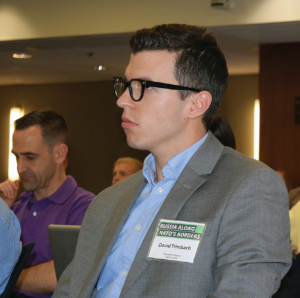
Sense of place is one of the Puget Sound Vital Signs, which measure the health of Puget Sound and progress toward its recovery. Sense of place fits into the group of Vital Signs that deal with human wellbeing. These Vital Signs describe how people benefit from a healthy Puget Sound. As Trimbach said, sense of place is key for people and their identities. “Having a sense that you are attached to a particular location is seen as contributing to an individual’s overall wellbeing and mental health,” he said.
The Sense of Place Vital Sign shows that over 70 percent of Puget Sound residents think Puget Sound plays a role in their identity, pride, and attachment to the region. A strong sense of place can help people unite to achieve big goals—like working toward a healthy Puget Sound. Trimbach explained that place attachment helps people develop habits that are beneficial for the environment. He and his colleagues Whitney Fleming and Kelly Biedenweg published a paper, Whose Puget Sound? Examining place attachment, residency, and stewardship in the Puget Sound region, in Geographical Review. The paper shows how all residents of the Puget Sound region—whether they’ve lived here for a long time or recently moved here—have strong place attachment and often engage in behaviors to take care of the environment.
In the Puget Sound region, there are many great efforts that focus on people’s sense of place to spur action. We Are Puget Sound and Puget Sound Starts Here are two notable examples. Both campaigns emphasize the key link between Puget Sound—the body of water and the region—and the people who call it home.
We Are Puget Sound – telling the story of Puget Sound by focusing on people
“Books can change lives. I wanted something that would inspire young people to develop an interest in Puget Sound.” – Brian Walsh
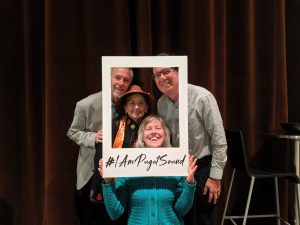
Brian Walsh cares deeply about Puget Sound. He’s spent much of his career working on environmental issues at Washington state agencies and he’s spent much of his free time taking photos that show Puget Sound’s natural beauty and rich diversity. A few years ago, Walsh had an idea for a book about Puget Sound, but he wanted it to be different from other books currently available. “I thought by focusing on people, we can tell the story of Puget Sound and the deep and abiding connection they have to the Sound,” he said. Walsh explained that, growing up, he’d been inspired by the Sierra Club book This is the American Earth, which featured powerful images taken by Ansel Adams to build public awareness and advocate for environmental protection. “Books can change lives,” he said. “I wanted something that would inspire young people to develop an interest in Puget Sound and become active, just as I had experienced years earlier.”
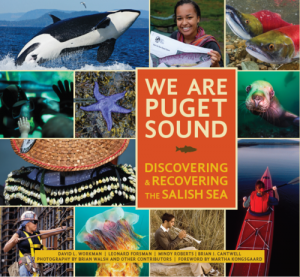
Walsh linked up with the writer David Workman—who, like Walsh, had worked at the Washington State Department of Ecology—and they began working on ideas for the book. The two connected with Mindy Roberts, Puget Sound program director for the Washington Environmental Council (WEC), who had also been thinking of writing a book about Puget Sound.
Roberts and WEC partnered with Walsh and Workman to make the book more than a book. The concept for We Are Puget Sound expanded to include a campaign to raise the profile of Puget Sound on a national level and to urge people to take action—for example, by voting in elections, supporting tribal treaty rights, or eating local foods. “To shape the campaign elements, we spoke with 20 community leaders around the region, including people from tribes, elected officials, journalists, nonprofit organizations, and just all-around innovative thinkers,” Roberts said. “Over several months, they helped hone the 10 actions that form the heart of the campaign with their valuable feedback.”
“There isn’t time to wait, and yet there is hope if we act now. People can make a difference.” – Helen Cherullo
Roberts, Workman, and Walsh brought the idea for the book to Braided River, the conservation imprint of Mountaineers Books. Helen Cherullo, executive director of Braided River and executive director of conservation and advancement for Mountaineers Books, explained that striking the right tone was one of the hardest aspects of putting the book together. She said it was crucial to provide honest information about the state of Puget Sound and the threats it faces, but also to give people real hope and useful solutions through the book’s list of ten actions to help Puget Sound. “There isn’t time to wait, and yet there is hope if we act now,” Cherullo said. “People can make a difference.”
The We Are Puget Sound campaign has held events throughout the region since the launch of the book to get people involved. The events have included pre-pandemic town halls, talks by Roberts, Workman, and Walsh, and a lobbying day in Olympia. Later events have been web-based, and featured topics like farmland, rain gardens, orca health, and sharing Puget Sound experiences through art. Roberts said, “We pivoted quickly to virtual events this spring and found that there’s a deep interest in these subjects and that people are willing to engage virtually even when we can’t all be together. Now we’re tailoring a whole series to relaunch this fall and into 2021.”
“We Are Puget Sound is about connecting people to place and to each other.” – Mindy Roberts
The centerpiece of the book is people and their stories. Both Roberts and Walsh said the stories are what they found especially inspiring. There are profiles of tribal members who work on conservation, environmental activists, volunteers, shellfish industry workers, former politicians, and others.
“Some names you may have heard before, but others you need to learn because these are the people who are making change in their communities,” Roberts said.
“I was blown away by a lot of the stories we heard,” Walsh said. “It was a revelation to me.”
And Walsh thinks that it is the story of Puget Sound that unites the people who live here, the stories we can tell about species like salmon and orcas. “This body of water connects us, and the vast biological treasure of this region,” he said. “I think there are a lot of common experiences that Puget Sound provides that unite us culturally and socially.”
“We Are Puget Sound is about connecting people to place and to each other,” Roberts said. “The more we strengthen these connections, the more people realized how deeply their everyday decisions impact or benefit the Salish Sea and the communities that depend on it.”
Puget Sound Starts Here
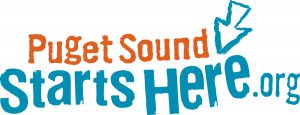
Showing people that their actions make a difference to the health of Puget Sound can inspire long-term changes to their habits. That’s the idea behind Puget Sound Starts Here, an ongoing campaign that works to stop pollution from entering Puget Sound.
The Sound Behavior Index has been getting better and was the highest it’s ever been in 2019.
Puget Sound Starts Here works by prompting folks to think about the place they live and take a look at the everyday sources of pollution—leaky cars, dog waste, home car washes, and yard fertilizer. The campaign helps people learn about why those pollution sources are harmful to Puget Sound and provides concrete steps people can take to alter their habits.
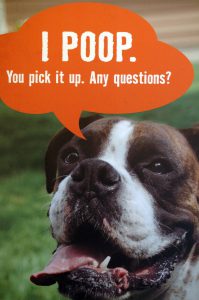
Mary Rabourn, communications specialist with King County Water and Land Resources division, explained that the campaign works because it’s focused on a shared goal of protecting our water resources and because it gives people an entry to making good environmental choices. “Each of the four areas of focus is a gateway for a personal interest that a consumer, or resident, or business has.” Rabourn said that pollution in Puget Sound is a big problem that will only be fixed through many varied approaches, including policy change and new technology. “But there is a role for individual action and localized action,” she said. “It’s a great way to bring people on board, because we need communities to pitch in.”
“We’re sharing and building on the resources of each city and county and trying to get every resident access to this information.” – Mary Rabourn
Puget Sound Starts Here is the result of different local and city governments putting their stormwater resources together to do something big. As Rabourn said, “It’s smart government. We’re sharing and building on the resources of each city and county and trying to get every resident access to this information. It extends our collective impact.”
The campaign encourages people to help restore the Sound through collective action, and they’re inspired to do so because of their experiences. “We have residents who have been here for a long time, who deeply identify with this area and the mountains, the water, the wildlife, and even the rain,” Rabourn said. “And then we have new people moving in, and this is where it’s super fun to engage new audiences. We know that there are key times when people are open to change, and one of those is when people move into a new area.”
Rabourn said that she was happy to see the recent update to the Sound Behavior Index, one of the indicators for the Sound Stewardship Vital Sign, which shows whether residents behave in ways that help improve water quality in Puget Sound. The Sound Behavior Index has been getting better and was the highest it’s ever been in 2019. More people have changed their habits to do things that help improve water quality and have cut out harmful habits.
“There’s been over 15 years of investment in education outreach and joint programs with Puget Sound Starts Here,” Rabourn said. “It has really embedded those behaviors in our region. We’ve seen a big payoff.”
How to get involved
The We Are Puget Sound campaign will continue holding virtual events throughout fall 2020 and, as Roberts mentioned, has a number of programs planned for spring 2021. The We Are Puget Sound book and website both feature a list of 10 things people can do to take action for Puget Sound. The campaign continues to highlight people and their affection for Puget Sound. We Are Puget Sound shared two videos—one from Lillian Greer and one from Ralph Monroe—that show their experiences with Puget Sound.
September was Puget Sound Starts Here Month for 2020, and the Puget Sound Starts Here campaign scheduled virtual events for September, October, and November. Puget Sound Starts Here also offers ways for people to get involved throughout the year by taking action through four key areas: using natural yard care, picking up after their pets, fixing car leaks, and creating rain gardens. When people around Puget Sound make small changes, it adds up to cleaner, healthier water.
Vital Sign connections
The Vital Signs measure the health of Puget Sound and progress toward its recovery.
Sense of Place
Sense of place measures how people identify with a place and feel a positive attachment to it. The We Are Puget Sound book features profiles of people throughout the Puget Sound region who care deeply about the health of Puget Sound and the communities who live by its shores. Puget Sound Starts Here engages with people who identify with the Puget Sound region and take pride in the place where they live.
Sound Stewardship
Puget Sound residents engage in environmental stewardship activities that they perceive as meaningful to themselves, their community, and the environment. Both the We Are Puget Sound and Puget Sound Starts Here campaigns encourage people to take care of natural resources and support the recovery of Puget Sound.
Freshwater Quality
Stormwater runoff, as it flows over paved surfaces, picks up and carries urban pollutants to local streams and rivers. Puget Sound Starts Here helps people develop habits that prevent stormwater runoff pollution from entering Puget Sound waterways.
Local Foods
The Local Foods Vital Sign broadly addresses the quality and availability of Puget Sound food resources for traditional, subsistence, and recreational uses. One of the 10 actions proposed by the We Are Puget Sound book and campaign is for people to seek out and eat local foods. From the We Are Puget Sound site: “This is the time to focus our efforts on community care by supporting each other and our regional farmers and fishers who grow and harvest food in ways that do not negatively affect our shared waters, strengthen local economies and improve food security and supply community food co-ops.”


